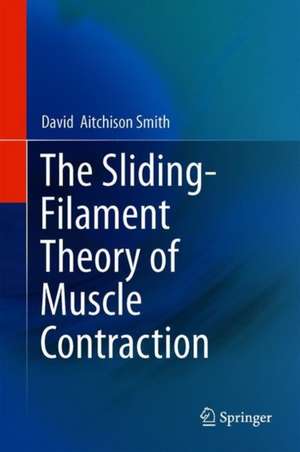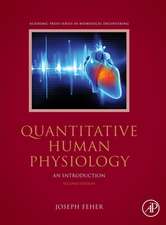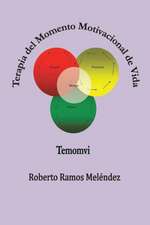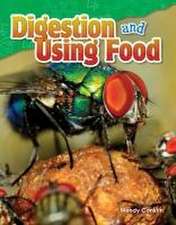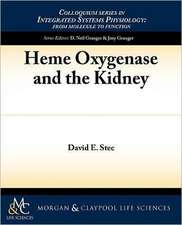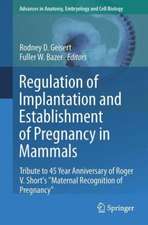The Sliding-Filament Theory of Muscle Contraction
Autor David Aitchison Smithen Limba Engleză Hardback – 20 feb 2019
After reviewing the mechanical and biochemical background, this monograph shows how old and new experimental discoveries can be modelled, interpreted and incorporated into a coherent mathematical theory of contractility at the molecular level. The theory is applied to steady-state and transient phenomena in muscle fibres, wing-beat oscillations in insect flight muscle, motility assays and single-molecule experiments with optical trapping. Such a synthesis addresses major issues, most notably whether a single myosin motor is driven by a working stroke or a ratchet mechanism, how the working stroke is coupled to phosphate release, and whether one cycle of attachment is driven by the hydrolysis of one molecule of ATP. Ways in which the theory can be extended are explored in appendices.
A separate theory is required for the cooperative regulation of muscle by calcium via tropomyosin and troponin on actin filaments. The book reviews the evolution of models for actin-based regulation, culminating in a model motivated by cryo-EM studies where tropomyosin protomers are linked to form a continuous flexible chain. It also explores muscle behaviour as a function of calcium level, including emergent phenomena such as spontaneous oscillatory contractions and direct myosin regulation by its regulatory light chains. Contraction models can be extended to all levels of calcium-activation by embedding them in a cooperative theory of thin-filament regulation, and a method for achieving this grand synthesis is proposed.
Dr. David Aitchison Smith is a theoretical physicist with thirty years of research experience in modelling muscle contractility, in collaboration with experimental groups in different laboratories.
Preț: 1112.17 lei
Preț vechi: 1170.71 lei
-5% Nou
Puncte Express: 1668
Preț estimativ în valută:
212.84€ • 231.11$ • 178.78£
212.84€ • 231.11$ • 178.78£
Carte disponibilă
Livrare economică 01-15 aprilie
Preluare comenzi: 021 569.72.76
Specificații
ISBN-13: 9783030035259
ISBN-10: 3030035255
Pagini: 442
Ilustrații: XV, 426 p. 164 illus., 58 illus. in color.
Dimensiuni: 155 x 235 mm
Greutate: 0.86 kg
Ediția:1st ed. 2018
Editura: Springer International Publishing
Colecția Springer
Locul publicării:Cham, Switzerland
ISBN-10: 3030035255
Pagini: 442
Ilustrații: XV, 426 p. 164 illus., 58 illus. in color.
Dimensiuni: 155 x 235 mm
Greutate: 0.86 kg
Ediția:1st ed. 2018
Editura: Springer International Publishing
Colecția Springer
Locul publicării:Cham, Switzerland
Cuprins
Textul de pe ultima copertă
Understanding the molecular mechanism of muscle contraction started with the discovery that striated muscle is composed of interdigitating filaments which slide against each other. Sliding filaments and the working-stroke mechanism provide the framework for individual myosin motors to act in parallel, generating tension and loaded shortening with an efficient use of chemical energy. Our knowledge of this exquisitely structured molecular machine has exploded in the last four decades, thanks to a bewildering array of techniques for studying intact muscle, muscle fibres, myofibrils and single myosin molecules.
After reviewing the mechanical and biochemical background, this monograph shows how old and new experimental discoveries can be modelled, interpreted and incorporated into a coherent mathematical theory of contractility at the molecular level. The theory is applied to steady-state and transient phenomena in muscle fibres, wing-beat oscillations in insect flight muscle, motility assays and single-molecule experiments with optical trapping. Such a synthesis addresses major issues, most notably whether a single myosin motor is driven by a working stroke or a ratchet mechanism, how the working stroke is coupled to phosphate release, and whether one cycle of attachment is driven by the hydrolysis of one molecule of ATP. Ways in which the theory can be extended are explored in appendices.A separate theory is required for the cooperative regulation of muscle by calcium via tropomyosin and troponin on actin filaments. The book reviews the evolution of models for actin-based regulation, culminating in a model motivated by cryo-EM studies where tropomyosin protomers are linked to form a continuous flexible chain. It also explores muscle behaviour as a function of calcium level, including emergent phenomena such as spontaneous oscillatory contractions and direct myosin regulation by its regulatory light chains. Contraction models can be extended to all levels of calcium-activation by embedding them in a cooperative theory of thin-filament regulation, and a method for achieving this grand synthesis is proposed. Dr. David Aitchison Smith is a theoretical physicist with thirty years of research experience in modelling muscle contractility, in collaboration with experimental groups in different laboratories.
After reviewing the mechanical and biochemical background, this monograph shows how old and new experimental discoveries can be modelled, interpreted and incorporated into a coherent mathematical theory of contractility at the molecular level. The theory is applied to steady-state and transient phenomena in muscle fibres, wing-beat oscillations in insect flight muscle, motility assays and single-molecule experiments with optical trapping. Such a synthesis addresses major issues, most notably whether a single myosin motor is driven by a working stroke or a ratchet mechanism, how the working stroke is coupled to phosphate release, and whether one cycle of attachment is driven by the hydrolysis of one molecule of ATP. Ways in which the theory can be extended are explored in appendices.A separate theory is required for the cooperative regulation of muscle by calcium via tropomyosin and troponin on actin filaments. The book reviews the evolution of models for actin-based regulation, culminating in a model motivated by cryo-EM studies where tropomyosin protomers are linked to form a continuous flexible chain. It also explores muscle behaviour as a function of calcium level, including emergent phenomena such as spontaneous oscillatory contractions and direct myosin regulation by its regulatory light chains. Contraction models can be extended to all levels of calcium-activation by embedding them in a cooperative theory of thin-filament regulation, and a method for achieving this grand synthesis is proposed. Dr. David Aitchison Smith is a theoretical physicist with thirty years of research experience in modelling muscle contractility, in collaboration with experimental groups in different laboratories.
Caracteristici
This book is the first to provide a unified description of the mathematics of muscle contraction
It provides a synthesis of theory and experiment in a field which has been driven to maturity by experimental discoveries
An ideal introduction to those who want to learn the intricacies of myosin motors
It provides a synthesis of theory and experiment in a field which has been driven to maturity by experimental discoveries
An ideal introduction to those who want to learn the intricacies of myosin motors
